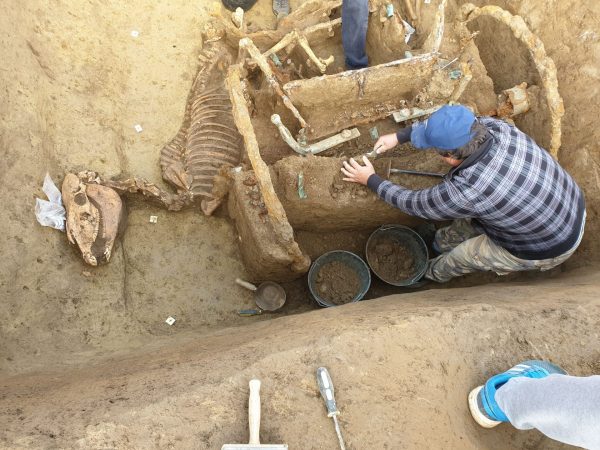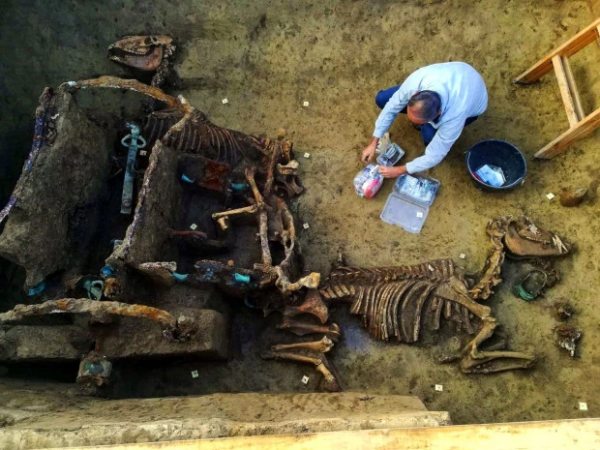Roman Chariot & Horses Found in Burial Chamber
Who says you can’t take it with you? Taking necessary or favored possessions with you into the afterlife was a common idea in the ancient world.
The most well-known example of a society using the practice of surrounding the dead with their belongings is the Egyptians, but the practice has also been used among many other ancient peoples, including the Vikings and, apparently, the ancient Romans.
Croatian archaeologists recently uncovered the remains of a two-wheeled Roman chariot, called a cisium, and two horses to go with it.
Preliminary estimations suggest that the find may date back to the third century. The find was part of a burial ritual called tumuli, which is a burial method that was favored by the richest and most powerful Roman families, according to Croatia Week newspaper.

The chamber is at the Jankovaka Dubrava site, located near the Croatian village of Stari Jankovci, in what used to be known as the Roman province of Pannonia.
A spokesperson from the Institute of Archaeology in Zagreb called it a unique and sensational find for Croatia. The institute has plans to undertake the restoration and conservation of the entire burial chamber, which may take several years.
They hope to learn more about the family who had enough cash and clout to use this sort of funerary method, as such families often had great economic, social or political power in the Roman Empire.
Even determining whether the horses were of local breeding or came from somewhere else will provide clues about the family who owned the chamber.

Boris Kratofti, a curator from the city Museum Vincovci, told media sources covering the find that such ancient burial mounds, were exceptional during the Roman period in the area, because of the type of people who used them.
The Romans began to move into Croatia around 229 BC, and by about 12 AD had established control over the entire area. That control continued until collapsing in fifth century, putting this find well into the time span of Roman rule.
The chariot was invented around 1700 BC and was one of Rome’s best weapons against its enemies for a thousand years, only declining when the Assyrians began incorporating more cavalry forces into their armies. By the first century, Romans only used chariots for processions and racing.
The Vincovci area has had other interesting finds dating from the Roman period. In 2012, World Archaeology reported that professional archaeologists uncovered a hoard of nearly fifty pieces of luxury silver tableware, including jugs, bowls, spoons, and plates.
Many of the items in that cache are decorated with engravings of everything from plants to building, or are decorated with gold plate. That find dates from late in the fourth century.
Archaeologists in Croatia unearth incredibly well-preserved fossilised remains of a Roman chariot buried with two horses ‘1,700 years ago’ https://t.co/IFx84E2nah
— Daily Mail Online (@MailOnline) October 17, 2019
The silver was found in a Roman, brick-lined pit, a spokesperson for the City Museum said at the time. It was found in the course of an investigation prior to the onset of some construction work that was being planned in the city center.
Because the area is part of a protected heritage zone, such archaeological surveys need to be made before any new development can get under way.
The surveys are done either by the representatives from the City Museum or by an outside company, which is what happened in this case.
When the silver hoard was discovered, it was considered to be the most important archaeological find in the area to date, which is saying something when you know that over the last forty or fifty years excavations in and around Vincovci have proven the area has been continuously occupied by humans for at least 8,000 years.
Scholars believe that the loot was stashed for safekeeping, since it dates from the period when the Roman hold on Croatia was beginning to weaken.
The burial chamber with the chariot and horses may just trump the silver for the role of most important discovery, though.
Another Article From Us: Found in Permafrost: 2,300-Year-Old Cabin Rebuilt
Given the number of finds that have already been made, and the fact that the city is rigorous about conducting surveys before new construction, even the chariot and the chamber it was found in may not hold that position for long.





